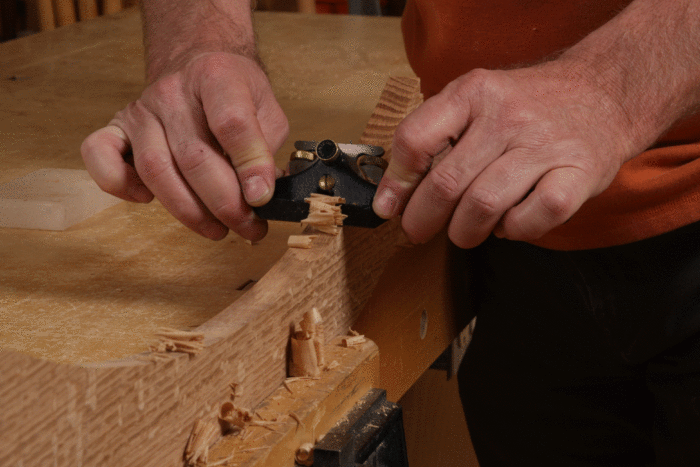
I recently completed a writing desk that had curves and contours nearly everywhere—in the legs, the aprons, the drawer fronts, and even the top. All of those curves meant that my trusted handplane had to stay on the shelf for extended periods. The handplane, after all, is designed to make things straight and flat—hardly what you want when working with curves. For this project, I reached instead for the handplane’s versatile cousin, the spokeshave.
Spokeshaves are simple tools, consisting of a wooden and/or metal body with handles, a blade, and a narrow sole. The tool often is associated with chair makers who use it with a drawknife for shaping spindles, legs, and rungs. But with a spokeshave, you can perfect and smooth any number of curved furniture parts, from complex cabriole legs to simple arched table aprons.
There are many diverse styles and models of spokeshaves. Although some woodworkers classify spokeshaves based on the material from which they are made (wood vs. metal), the real difference among these tools is how the blade is oriented in the body (bevel up or bevel down) and thus the cutting angle created by that orientation.
Spokeshaves that have blades bedded bevel up have low cutting angles, from 20° to 35° depending on the bevel angle. The lower cutting angle makes it easy to take heavy cuts. Spokeshaves with blades bedded bevel down, which I call standard-angle shaves, have a steeper cutting angle of around 45°. The steep cutting angle deftly handles tricky grain.
Both low- and standard-angle shaves have their places. The secret lies in knowing which type of shave is best suited to the work that you do.

Low-angle shaves can take heavy cuts
Low-angle spokeshaves have a number of advantages. The shaves seldom jam because they have no lever cap or chipbreaker, which gives shavings an unobstructed path to pass through. This design allows the shaves to handle heavy shavings and thin, wispy ones equally well.
Unlike older versions of low-angle shaves, which had blades with tangs on the ends that were pressed into the shave’s body, modern shaves rely on threaded posts and thumbscrews to hold the blade rock solid. The design allows for easy blade removal and a fit that doesn’t loosen over time. Many of these shaves employ setscrews to regulate blade depth, making it easy to reset things after sharpening.
Low-angle shaves slice effortlessly through straight-grained wood, which is why chair makers often favor them for whittling and shaping rived, green wood into arms, legs, rungs, and spindles. Low-angle shaves work great on end grain, too, because their low cutting angle slices cleanly across the fibers.
On the downside, the small sole (only in front of the blade) and low cutting angle make this category of shaves less predictable and harder to control when smoothing curves along a board’s length, as in cabriole legs, arched aprons, and curved slats. Also, when a low-angle shave encounters areas of figured or reversing grain, it is prone to lifting and tearing out the wood.
Standard-angle shaves handle tricky grain
The design of a standard-angle spokeshave is akin to that of a bench plane. It has a sole that surrounds the blade, making the tool easier to control, and it typically is equipped with a lever cap that acts as a chipbreaker. As a shaving enters the throat, it is broken abruptly by the steeply pitched blade and lever cap, weakening its ability to tear the grain. Many standard-angle shaves also make setting the blade easy and ensure that, once set, it will stay set. Like their low-angle counterparts, they can be pushed or pulled. In general, this good all-around performer is the shave to pick if you can afford only one.
The steeper 40° to 55° cutting angle helps these tools handle tricky grain well, leaving the wood with a clean, smooth surface, even when shaping figured or reversing grain. The downside is that the tool requires more force in use, and, if not sharpened and well tuned, is liable to skip and chatter.







